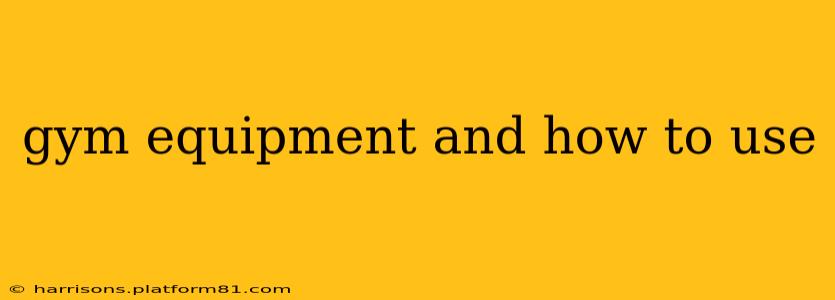Navigating a gym filled with unfamiliar equipment can be daunting, even for seasoned fitness enthusiasts. This comprehensive guide breaks down common gym machines and free weights, explaining their proper usage and benefits. We'll also address some frequently asked questions to ensure you're confident and safe in your workout routine. Remember to always consult your doctor before starting any new workout program.
Types of Gym Equipment
Gym equipment broadly falls into two categories: cardio equipment and strength training equipment.
Cardio Equipment
Cardiovascular exercise improves heart health, burns calories, and enhances endurance. Popular options include:
-
Treadmills: These allow for walking, jogging, or running at adjustable speeds and inclines. Proper form involves maintaining an upright posture, engaging your core, and landing midfoot to minimize impact.
-
Elliptical Trainers: These offer a low-impact workout that targets both upper and lower body. Focus on maintaining a smooth, consistent motion and avoiding jerky movements.
-
Stationary Bikes: These are excellent for improving lower body strength and cardiovascular health. Maintain proper posture and adjust resistance as needed.
-
Rowing Machines: Rowing provides a full-body workout, engaging major muscle groups. Focus on proper technique – a controlled pull, straight back, and engaged core – to avoid injury.
Strength Training Equipment
Strength training builds muscle mass, increases metabolism, and improves bone density. This equipment includes:
-
Weight Machines: These machines guide your movements, reducing the risk of injury, and are ideal for beginners. Each machine has specific instructions; read them carefully before use.
-
Free Weights (Dumbbells and Barbells): These offer greater freedom of movement but require proper form to prevent injuries. Start with lighter weights and gradually increase as you get stronger.
-
Cable Machines: These provide consistent resistance throughout the range of motion. Adjust the weight and pulley position according to the exercise.
-
Resistance Bands: These portable and affordable tools offer versatile resistance for various exercises. Choose the appropriate resistance level based on your strength.
Frequently Asked Questions (FAQs)
Here are some common questions regarding gym equipment and usage:
How do I choose the right weight?
Choosing the right weight depends on your fitness level and the specific exercise. Begin with a weight that challenges you but allows you to maintain proper form for the recommended number of repetitions. If you can't maintain proper form, decrease the weight. If the exercise feels too easy, increase the weight.
What is proper form and why is it important?
Proper form refers to the correct technique and posture for each exercise. It's crucial for preventing injuries, maximizing muscle activation, and achieving optimal results. Watch instructional videos, work with a trainer, or observe experienced gym-goers to learn proper form.
How often should I work out?
The frequency of your workouts depends on your fitness goals and recovery capacity. Beginners might start with 2-3 sessions per week, while more experienced individuals might train more frequently. Listen to your body and allow for adequate rest between workouts.
What are some common gym mistakes to avoid?
Common mistakes include using excessive weight, neglecting proper form, neglecting warm-up and cool-down routines, and not allowing sufficient rest between sets and workouts. Prioritize proper technique over lifting heavy weights.
How can I create a workout routine?
A balanced workout routine should incorporate both cardio and strength training exercises. Consider your fitness goals – building muscle, improving endurance, losing weight – when designing your routine. A certified personal trainer can help create a personalized plan.
Conclusion
Understanding gym equipment and how to use it safely and effectively is essential for achieving your fitness goals. Remember that consistency, proper form, and listening to your body are key factors in a successful workout journey. With a little knowledge and effort, you can confidently navigate the gym and build a strong, healthy body. Remember to consult a healthcare professional before starting any new exercise program.
